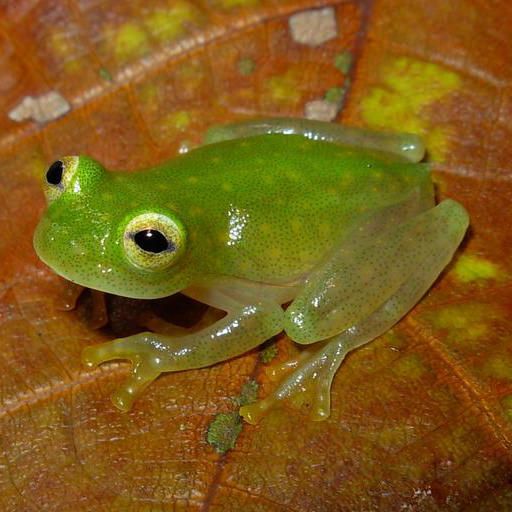The glass frog is endangered due to habitat loss and fragmentation caused by deforestation and urbanization. This has resulted in a decline in population and threats to its survival.

Credit: www.rainforest-alliance.org
Habitat Destruction: A Major Threat
The glass frog is facing endangerment primarily due to habitat destruction, with deforestation being a major threat. Deforestation is causing a significant impact on the glass frog population due to the destruction of its natural habitat. This destruction leads to the loss of breeding sites for these unique amphibians.
As their habitats continue to diminish, their survival becomes increasingly difficult. The glass frog relies on specific habitat conditions for breeding, which includes the availability of suitable vegetation and clean water sources. With the continuous destruction of forests for various reasons, such as agriculture and urbanization, the glass frog is losing its homes at an alarming rate.
Urgent and concerted efforts are needed to address this issue and protect the glass frog from further decline.
Climate Change: Another Contributor
The glass frog is facing endangerment, with climate change identified as another contributor. Global warming triggers altered weather patterns, ultimately impacting the fragile ecosystem where these unique amphibians reside. The rising temperatures disrupt the delicate balance necessary for their survival.
The glass frog’s habitat is highly sensitive, and even slight changes in temperature can have devastating effects. Warmer temperatures alter the natural cycles of the environment, affecting the availability of resources and the intricate web of interactions. These changes diminish the chances of successful reproduction and the overall well-being of the glass frog population.
As global warming continues to intensify, it is crucial to recognize and address its effects on the glass frog and take necessary measures to ensure their long-term survival.
Human Activities And Their Consequences
Human activities have had detrimental consequences for the glass frog, contributing to its endangered status. Pollution and water contamination pose significant threats, as industrial waste and chemical runoff find their way into the frog’s habitat. These contaminants degrade the water quality, essential for the frog’s survival and reproduction.
Additionally, deforestation and urbanization have led to habitat loss, further endangering the glass frog population. Another alarming factor is the illegal wildlife trade, where glass frogs are captured and sold as exotic pets. This merciless exploitation disrupts the fragile ecological balance, pushing the species closer to extinction.
Awareness regarding these human-induced threats is crucial in implementing conservation efforts to protect the glass frog and its fragile ecosystem.
Frequently Asked Questions Of Why Is The Glass Frog Endangered?
Why Is The Glass Frog Endangered?
The glass frog is endangered due to habitat loss caused by deforestation and human activities. They are also at risk from pollution and climate change. Their small habitat range and low reproductive rate further contribute to their vulnerable status.
What Is The Habitat Of The Glass Frog?
The glass frog is primarily found in the forests of central and south america, particularly in countries like costa rica, ecuador, and panama. These frogs inhabit the understory of tropical rainforests, living near streams and rivers.
What Are The Main Threats To The Glass Frog Population?
The main threats to the glass frog population include deforestation, habitat degradation, and human activities such as logging and agriculture. Pollution, climate change, and the introduction of non-native species also pose significant risks to their survival.
How Does Deforestation Affect The Glass Frog?
Deforestation directly impacts the glass frog by destroying their natural habitat. It eliminates the trees and vegetation that provide them with food and shelter. Without suitable habitats, the frog population declines, leading to a higher risk of extinction.
What Role Does Climate Change Play In Glass Frog Endangerment?
Climate change disrupts the delicate balance of the glass frog’s ecosystem. Rising temperatures can alter their habitat, affecting their breeding patterns and reproductive success. These changes can ultimately disrupt the entire food chain and lead to a decline in their population numbers.
Conclusion
The glass frog is an endangered species due to several factors that threaten its survival. Deforestation and habitat destruction have drastically reduced the frog’s natural habitat, leaving it vulnerable to extinction. Additionally, climate change has altered the environmental conditions that the glass frog relies on for reproduction and survival.
Pollution, particularly from pesticides and herbicides, further harms the frogs and their ecosystems. Furthermore, illegal pet trade and collection for scientific research have contributed to the decline of glass frog populations. To protect this unique species, it is crucial for governments and communities to prioritize conservation efforts.
Raising awareness about the importance of preserving the glass frog’s habitat and implementing sustainable practices are essential steps in saving this endangered amphibian. By taking action, we can ensure the long-term survival of the glass frog and maintain the biodiversity of our planet.
